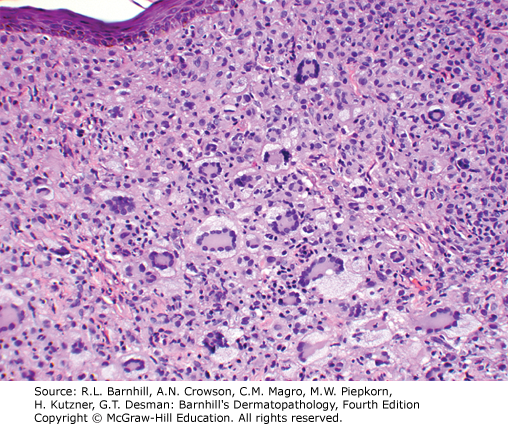Dermatology Question of the Week: Deductive Dermpath

Question:
An 8-year-old patient presents with multiple lesions with the histopathology shown below.

Which of the following would be appropriate screening?
Answer choices:
A. SPEP/Serum immunofixation
B. Hgb A1c
C. Lipid panel
D. Rheumatoid factor
E. Ophthalmologic exam
Rationale: The findings above are consistent with a xanthogranuloma. Mature xanthogranulomas are characterized by dense sheets of histiocytes with Touton giant cells and wreath giant cells.
Correct answer: E Ophthalmologic exam
Patients with multiple cutaneous (juvenile) xanthogranulomas are at increased risk of ocular involvement and these patients should be screened by an ophthalmologist, particularly anyone reporting any ocular symptoms.
Incorrect answers:
A. SPEP/serum immunofixation. Necrobiotic xanthogranulomas are comprised of a granulomatous nodule with X-shaped zones of necrosis, Touton giant cells may be seen as well. These typically have deeper involvement including the dermis and subcutis; cholesterol clefts can be seen. Necrobiotic xanthogranulomas can be associated with underlying paraproteinemia.


B. Hgb A1c. Necrobiosis lipoidica can be associated with underlying diabetes. This typically presents as layers of granulomatous inflammation alternating with layers of degenerated collagen. This is not similar to the presentation above.

C. Lipid panel. Eruptive xanthomas can be seen with high levels of triglycerides. On histology, they appear as foam cells with lots of extracellular lipid as the rapid process overwhelms the capacity of histiocytes; frequently accompanied by a collection of neutrophils as seen below.

D. Rheumatoid factor. Rheumatoid nodules typically present as a large palisaded granuloma which surrounds pink fibrin. This is not seen in the photograph above.

Additional reading at Barnhill's Dermatopathology Chapter 6: Nodular and Diffuse Cutaneous Infiltrates.
References:
So N, Liu R, Hogeling M. Juvenile xanthogranulomas: Examining single, multiple, and extracutaneous presentations. Pediatr Dermatol. 2020 Jul;37(4):637-644. doi: 10.1111/pde.14174. Epub 2020 May 28. PMID: 32468628.

Create a Free MyAccess Profile
AccessMedicine Network is the place to keep up on new releases for the Access products, get short form didactic content, read up on practice impacting highlights, and watch video featuring authors of your favorite books in medicine. Create a MyAccess profile and follow our contributors to stay informed via email updates.